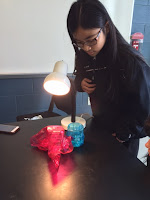 This week, students began exploring a classic of their own choosing. By the end of March, each student will defend (in letter form) why their classic merits acceptance into the BHHS Museum of Classics (completely fictional, by the way). Students will have to determine the criteria for what makes a classic as well as why their classic fits the bill. Students began their exploration in the BHHS Media Center, where Mrs. Bevier had pulled dozens of books about a wide variety of classics--poems, cars, desserts, songs, mythology, photographs, musicals, architecture, cartoons, and more.
This week, students began exploring a classic of their own choosing. By the end of March, each student will defend (in letter form) why their classic merits acceptance into the BHHS Museum of Classics (completely fictional, by the way). Students will have to determine the criteria for what makes a classic as well as why their classic fits the bill. Students began their exploration in the BHHS Media Center, where Mrs. Bevier had pulled dozens of books about a wide variety of classics--poems, cars, desserts, songs, mythology, photographs, musicals, architecture, cartoons, and more.Now, students have selected their "classics," and, as usual, I am SO IMPRESSED by their creativity and individuality. Here are a few examples to showcase the students' thinking:
- Jade is interested in the bell-bottom jean as a classic shift in fashion.
- Nick P thinks the BMW e46 m3 should qualify as a classic car.
- Annaliese is investigating DC Comics as a classic comic book creator.
- Seth wants to prove that "It's a Man's Man's Man's World" by James Brown is a classic song.
- Tia is looking into Starbucks as a classic coffee shop chain.
- Abby S is defending a specific classic heart surgery technique.

What will the students think--should they be considered classics or not? Is the impact of Shakespearean language still felt today? Check out one hip hop artist who says yes!








